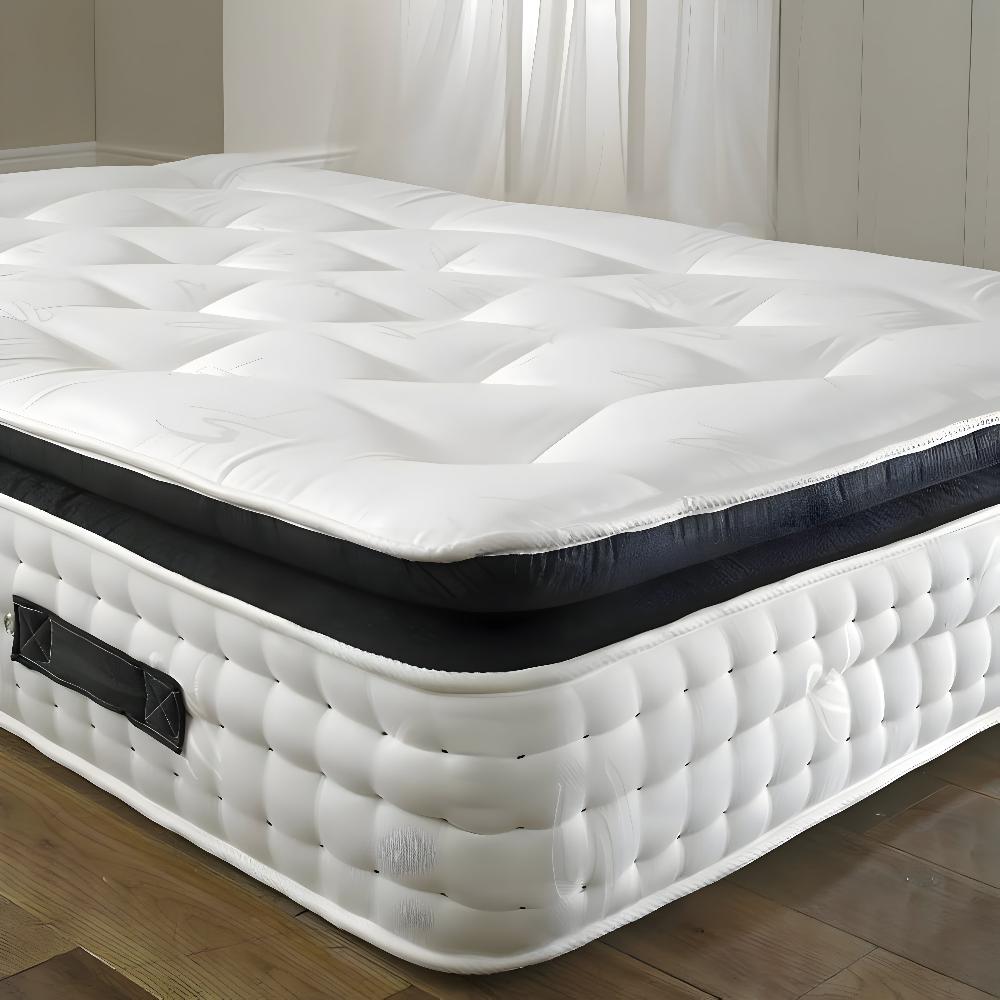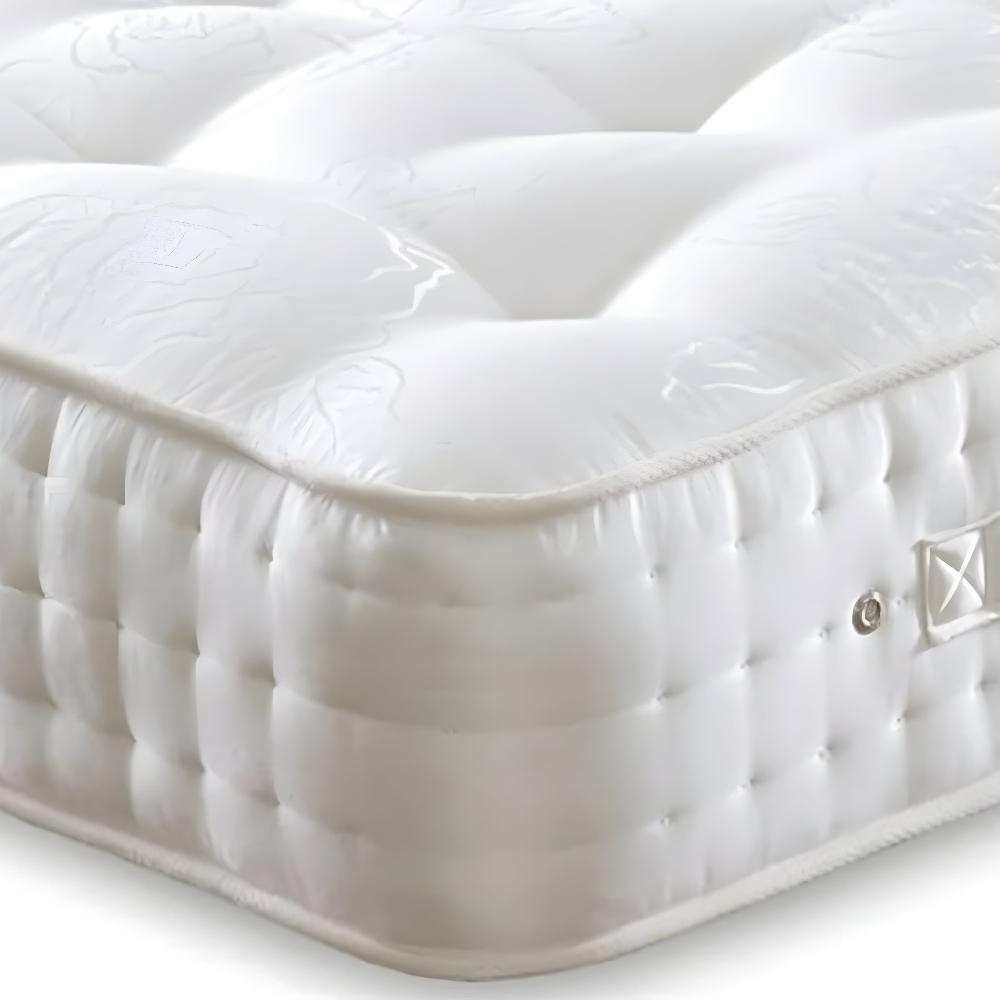Article: Best Double Mattresses for Side Sleepers

Best Double Mattresses for Side Sleepers
Find the perfect sleep match if you snooze on your side. Side Sleeper? Read This First. We get it—side sleeping feels right. It’s cozy. Natural. Comfortable. But here's the thing. If you wake up sore or stiff, your mattress might be working against you.
You’re not alone. This guide will help you find the best double mattress that supports how you sleep. You'll learn what side sleepers need in a mattress, see our top picks, and get answers to the most searched questions. Let’s dive in.
Why Side Sleepers Need Special Support
Side sleeping is great for your heart, digestion, and spine— If your mattress plays along. If not? You’ll feel the pain in your hips, shoulders, and lower back.
Pressure Points Are Real
When you sleep on your side, most of your weight hits your shoulder and hip. That’s why side sleepers need pressure relief more than anyone else. Hard mattresses press into your bones. Soft ones might feel good at first. But without support, you’ll sink too far.
Soft, But Not a Sinkhole
You want that sweet spot—the "just right" balance of soft comfort and solid support. Most side sleepers do best with a medium-soft to medium-firm feel. It cushions your pressure points—but keeps your spine aligned.

Keep Your Spine Happy
Your spine needs to stay straight, even while you sleep. If it bends or sags too much, 3pain shows up fast. A supportive double mattress keeps everything in line. And that means deeper sleep, fewer tosses, and fewer aches.
Best Double Mattresses for Side Sleepers
You don’t need to try 20 beds. We’ve done the hard part for you. Here are five mattresses side sleepers rave about:
1. Memory Foam Bliss
If you love that “hugged by the bed” feeling, this one’s for you. Memory foam moulds to your body. It gives where it needs to, and supports where it should.
Great for:
- Solo sleepers
- Couples who toss and turn
- Anyone with joint pain
Bonus: It also absorbs movement. So if your partner moves, you won't feel a thing.
2. Hybrid Heaven
Can’t decide between foam and springs? Get both. Hybrids combine the comfort of foam with the bounce of coils. They’re breathable, supportive, and built to last.
Great for:
- Hot sleepers
- Side sleepers who want bounce
- Couples needing edge support
It’s a win-win.
3. Latex Luxury
Want natural comfort? LaTeX delivers. It’s cooler than memory foam. And slightly bouncier too. You'll feel lifted, not sunk in.
Great for:
- Hot sleepers
- Eco-conscious shoppers
- People with allergies (latex is hypoallergenic!)
It’s a premium feel without the chemicals.
4. Pillow-Top Perfection
Love soft comfort but need structure underneath? Go pillow-top. You get a plush top layer that cushions every curve. Underneath, the mattress stays firm and supportive.
Great for:
- Side sleepers who need extra softness
- People with sensitive hips and shoulders
- Couples who want a touch of luxury
It’s like sleeping on a cloud—with support.
5. Budget-Friendly Comfort
Not ready to splurge? Look for memory foam or foam-hybrid models. They offer solid support and comfort without draining your wallet.
Great for:
- Guest rooms
- First apartments
- Side sleepers on a budget
You don’t have to spend big to sleep well.
Side Sleeping: Pros and Cons
Let's be real, side sleeping is super common. Most people naturally fall asleep on their sides. But is it good for you?
The Pros
- Better for digestion – Sleeping on your left side can help reduce acid reflux.
- Improves circulation – Side sleeping can help blood flow more easily.
- Good for back pain – When done right, it eases pressure off your spine.
- Reduces snoring – Keeps airways open and helps you breathe better.
The Cons
- Pressure on joints – Your shoulder and hip can take a hit if your mattress isn’t right.
- Wrinkles – Yep, your face pressed into the pillow nightly can lead to lines.
- Numb arms or legs – Bad alignment can restrict nerves or blood flow.
How Side Sleepers Affect Mattress Wear
Here’s something you may not have thought about. The way you sleep can affect how fast your mattress wears out. Side sleepers usually put more weight on a smaller surface area (your hip and shoulder).
Over time, that can lead to:
- Dips or indentations on one side
- Faster breakdown of foam in pressure zones
- Uneven firmness, especially in memory foam or cheaper models

So what can you do?
- Rotate your mattress every few months.
- Go for a mattress with zoned support
- Choose high-density foam or durable hybrid designs
A well-made mattress lasts longer, even for side sleepers.
Sleeping on the Left vs Right Side: Does It Matter?
You may be wondering. Does the side you sleep on really make a difference?
Turns out, yes—it can!
Left Side
- Better for digestion
- Helps reduce acid reflux
- May boost lymph drainage
Right Side
- Sometimes easier on the heart (especially during pregnancy)
- It can help relieve pressure on certain organs
For most people, the left side is recommended, especially after eating. But comfort is key. If the right side feels better, that's okay too. Whichever side you choose, make sure your body is well-aligned.
Why Double Mattresses Are Ideal for Side Sleepers
If you’re a side sleeper, mattress size matters. Here's why a double mattress is a smart pick.
Room to Move
Side sleepers often change positions during the night. A double mattress gives you space to shift around, without falling off the edge.
Great for Solo Sleepers
If you sleep alone, it’s roomy without feeling overwhelming. Much cozier than a king, and easier to fit in smaller bedrooms.

Ideal for Couples Who Like to Cuddle
Let’s be honest—some couples like to sleep close. If you're both side sleepers, a double gives you snuggle space without feeling too tight.
Budget-Friendly
Double mattresses are more affordable than queen or king sizes. You get comfort and space, without spending big.
So if you love sleeping on your side and want comfort + space, a double might be your perfect match.
How to Choose What’s Right for You
Let’s narrow it down. Choosing a mattress can be confusing. Here’s how to make it easy.
Match Your Body Type
Your size matters here.
- Lighter sleepers (under 150 lbs) often prefer softer foam.
- Heavier sleepers (200+ lbs) may need more firmness and deeper support.
No one-size-fits-all.
Try It Out—Really
Mattresses feel different when you lie on them for real. Online reviews help, but your body knows best. Spend at least 10–15 minutes on your side. Pay attention to your hips, shoulders, and back.
Sharing the Bed? Think Motion Control
If your partner moves in their sleep, you feel it. That's where foam shines. Latex and hybrids work too—if they’re designed well. Check reviews for “motion isolation” or “partner disturbance.”
Return Policy = Peace of Mind
Even the “perfect” mattress might not feel right after a few nights. So make sure there’s a good return policy. No stress. No regrets.
How to Tell If Your Mattress Needs Replacing
Still waking up sore—even on a decent mattress? It might be time for an upgrade. Here’s how to know if your mattress has run its course:
It's over 7–10 years old
Even the best mattresses lose their support over time. If it's past its prime, your sleep might be suffering.
You feel dips or sagging.
Lie down and feel a dip under your hip or shoulder? That's a red flag for side sleepers.

You wake up in pain
Aches in your lower back, shoulders, or neck could mean your mattress isn’t aligned anymore.
It feels too soft or too hard
Your mattress should support your body, not swallow it or push back hard.
You sleep better elsewhere.
If hotel beds or your friend's guest bed feel better than yours, that says a lot. If one or more of these feels true, it's time to start mattress shopping.
Final Thoughts: Don’t Settle for Less Sleep
Side sleeping is one of the healthiest sleep positions. But without the right mattress, it can do more harm than good. The right double mattress changes everything. Better support. Deeper sleep. Less pain. More energy. You deserve that. And now, you know how to get it.
FAQs
1. What firmness is best for side sleepers?
Go for medium-soft to medium-firm. It supports your spine while relieving pressure on your hips and shoulders. Too firm can cause joint pain, too soft may lead to sagging. Look for balance—you want both comfort and support.
2. How do I know if my mattress is too firm?
You’ll feel it in the morning. If your shoulders feel sore or tingly, it’s likely too firm. You may also notice numbness or stiffness after sleeping. If you feel like you're sleeping on the bed, not in it, it's too firm.
3. Can a topper fix a hard mattress?
Yes! A soft memory foam topper can make your bed feel brand new, without buying a whole new mattress. It’s a quick fix for pressure relief and added comfort. Great option if your mattress is still in good shape underneath.
4. What’s the ideal thickness?
Look for at least 10–12 inches. Thinner ones might not offer enough support over time. Thicker beds give better cushioning for hips and shoulders. They also last longer and feel more supportive overall.
5. Should I use a pillow between my knees?
Absolutely. It aligns your hips and keeps your spine straight. Perfect for side sleeping. It also reduces pressure on your lower back and hips.
6. How often should I replace my mattress?
Every 7–10 years. Sooner if it sags, feels lumpy, or you wake up with pain. Your body changes over time—your mattress needs to keep up. If your sleep is worse than before, it’s probably time.
Ready to Sleep Better?
Your dream mattress is out there—waiting. Now that you know what side sleepers need, you're already one step closer to better sleep.
- Start with one of the mattresses we mentioned.
- Try it out.
- Wake up refreshed.
Because good sleep isn’t a luxury—it’s a necessity.


